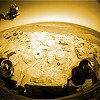 A plateau on the planet Mars called Home Plate looks like it had a volcanic past, according to the latest data from NASA’s rover Spirit. The data also support earlier hints at that water once existed at or beneath the planet’s surface.
A plateau on the planet Mars called Home Plate looks like it had a volcanic past, according to the latest data from NASA’s rover Spirit. The data also support earlier hints at that water once existed at or beneath the planet’s surface.
Home Plate has a finely layered appearance and so made it a tantalizing target for Spirit, according mission controller Steve Squyres. The rover captured its first panoramic image of Home Plate in August 2005 from the summit of Husband Hill and reached the plateau in the Columbia Hills’ inner basin in February 2006. Squyres called one of those images, “one of the neatest pictures we’ve taken with the rovers.”
The image shows nothing more than a small (4 cm) fragment of rock cradled within a downward deflection in otherwise straight layers. Earthly geologists refer to such features as bomb sags and they are usually formed only when a rock fragment (the bomb) is flung upward in an explosion and lands in soft material, causing it to sag.
Chemical analysis has demonstrated that the Martian rock is composed of basalt, a volcanic rock, which precludes it being a meteorite. The rock also carries tiny coagulated ash particles, which could only be present after ash rains down following a volcanic eruption.
NASA says any volcanic activity at Home Plate probably occurred billions, of years ago. “There are lots and lots of places on Mars where, from orbit, you see layered deposits locally that kind of look like this,” says Squyres, “and so it really raises the possibility that a lot of these things all over the planet could be explosive volcanic deposits.”
The fact that the Home Plate rocks are basalt also suggests water may have been present. Basalt is not normally associated with explosions. “When basalt erupts, it often does so as very fluid lava, rather than erupting explosively,” Squyres explains A notable exception comes when hot basalt meets water to cause a steam-driven explosion.
The Science paper is based on data collected during a frenetic few months in 2006, as Spirit was rolling down the Columbia Hills toward a safe place to ride out the Martian winter. The route to safety included a path across Home Plate – leaving Spirit’s drivers on Earth with a dilemma.
“There was all this fabulous science around us,” Squyres says. But with winter approaching, the team had to get Spirit to its safe spot on time, while gathering as much data as possible along the way. “We got an amazing amount of science done, all things considered,” he said. “But there’s more work to be done here.” Spirit is now back at Home Plate, continuing exploration there.
The team published further details of their findings in Science this week (2007, 316, 738-742).